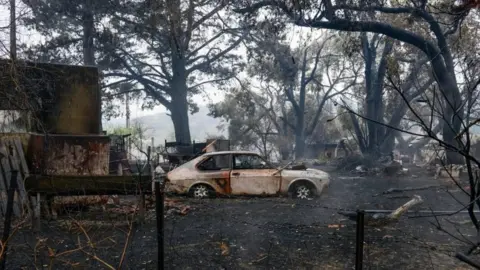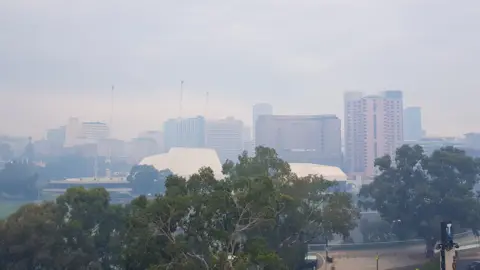Heatwave sweeps Australian cities and raises bushfire danger
 SOUTH AUSSIE WITH COSI
SOUTH AUSSIE WITH COSIA heatwave sweeping south-east Australia has sent temperatures soaring in the nation's biggest cities and escalated the threat of bushfires.
A large blaze has been contained in Adelaide, South Australia after it burned through 2,500 hectares.
Neighbouring Victoria state is facing its worst fire risk in a year.
Temperatures in those states have started to cool but New South Wales and Queensland will see their heatwave continue into Tuesday.
Sydney recorded temperatures of above 40C by Monday afternoon.
Health officials have urged people to stay inside and to avoid physical activity, and for those near bushfires to avoid inhaling smoke.
The blaze in the Adelaide Hills has been contained but is expected to continue to burn for the next few days, local media reports.
It is believed to have destroyed several houses but has not caused injuries.
 EPA
EPAPeople in the area have been warned to take care.
"Smoke will reduce visibility on the roads and there is a risk of trees and branches falling," a statement from SA police said.
Images taken on Monday show smoke over Adelaide obscuring parts of the city skyline and prompting some residents to wear face masks.
 PELIZARECA/TWITTER
PELIZARECA/TWITTERAfter the hot spell began on Friday, the Bureau of Meteorology (Bom) issued heatwave warnings for South Australia, Victoria, New South Wales, Tasmania and Queensland.
On Monday, Victoria's state capital Melbourne recorded temperatures of 41.5C at 12.40pm (01.40 GMT).
People in Victoria have been urged to be careful when in water after the state recorded seven drownings over the past 10 days, ABC News reports.
 EPA
EPAThe heat is expected to linger until mid-week as the hot air mass tracks east across the country.
'More hot days compared to previous decades'
After extreme bushfires and heatwaves a year ago, Australia's summer this year has so far been cooler and wetter. Meteorologists say the conditions are influenced by a La Nina phenomenon.
Australia has warmed on average by 1.4C since national records began in 1910, according to its science and weather agencies.
That's led to an increase in the number of extreme heat events, as well as increased fire danger days.
"In summer we now see a greater frequency of very hot days compared to earlier decades," said BoM and the national science agency, CSIRO, in their 2020 State of the Climate report.
The same report noted that 2019 - Australia's hottest year on record - had 33 days where the national maximum temperature exceeded 39C. That surpassed the total number of days over 39C in the previous six decades.
Heatwaves are Australia's deadliest natural disaster and have killed thousands more people than bushfires or floods.